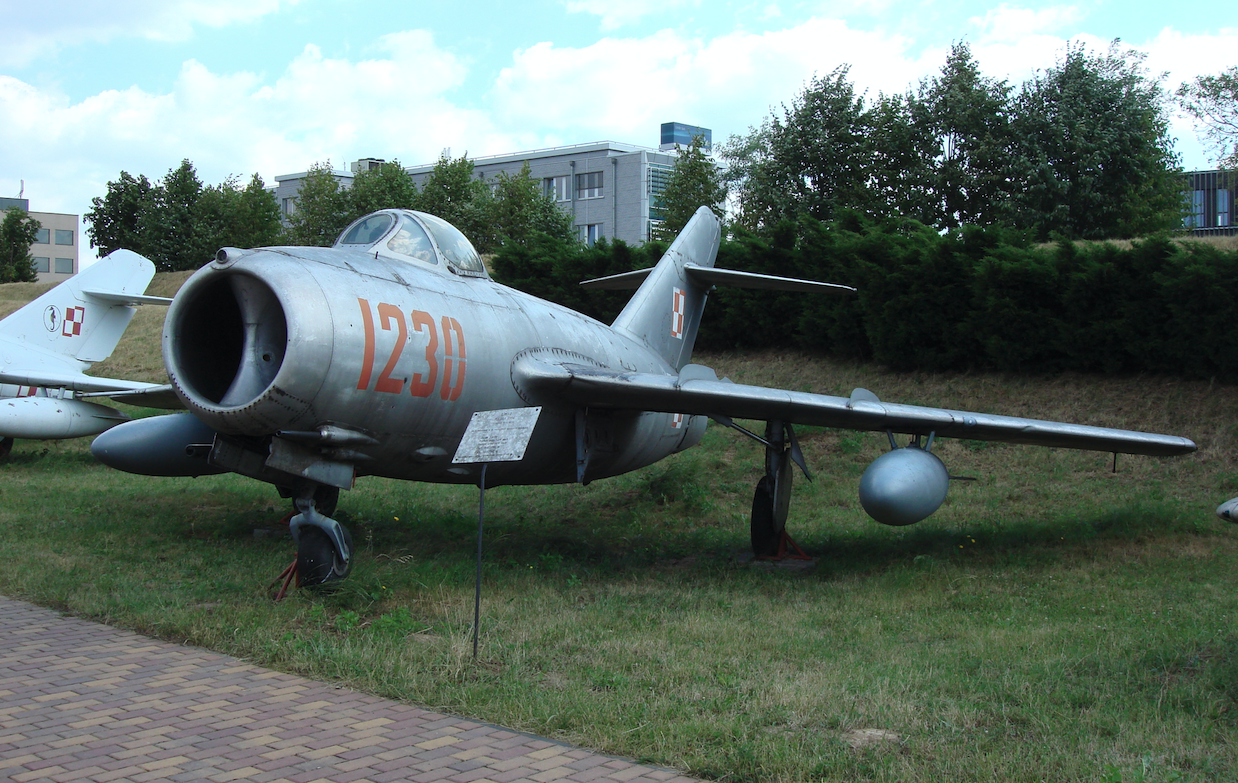Kraków 2009-03-16
Construction PZL Lim-2
117b Section 1954.09.17. WSK Mielec Lim-2.
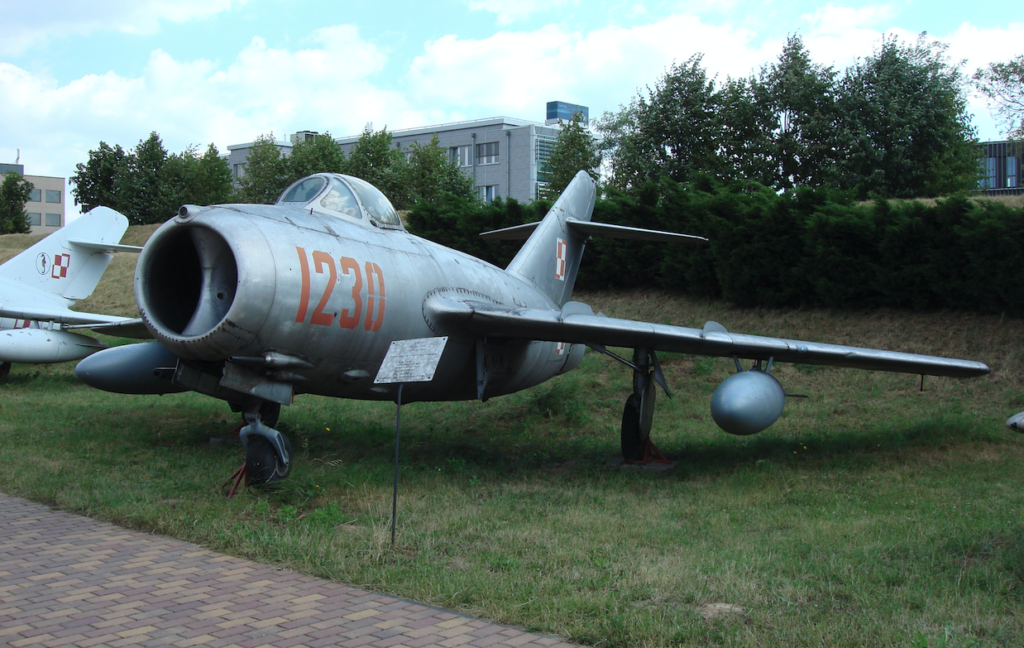
The PZL Lim-2 aircraft is a single-seat, single-engine front-line fighter, built in a classic layout. According to modern nomenclature, it is also a multi-role combat aircraft; it intercepts air targets, attacks ground objects, conducts reconnaissance and is used for training. Medium-wing. Semi-monocoque, metal construction, mainly D16-T duralumin was used, and in important places 30ChGSA steel.
Wings swept 37 degrees on the leading edge, negative lift -2 degrees, wedge angle 1 degree. The profile at the fuselage is symmetrical CAGI S-10s, with a relative thickness of 9%, at the end a CAGI SR-3-12 supporting profile, with a relative thickness of 12%. Single-spar supporting structure, with a rear auxiliary spar. Working skin with a thickness of 1 mm to 2 mm. At the end of the wing, a mass of 26 kg reducing vibrations (anti-flyer mass). On the upper surface, two pairs of aerodynamic guides, 10 cm high. Flaps of the spreader type, extend by 20 cm when lowered. For take-off, deflected 20 degrees, for landing 55 degrees. Area 1.18 square meters. Ailerons with an area of 0.505 square meters, deflected +- 15 degrees. Ailerons and flaps have internal aerodynamic compensation. Wing aspect ratio 4.85, convergence 1.61. Each wing is attached to the fuselage with three fittings. Under the left wing, near the fuselage, there is a deflectable landing spotlight. Lim-1 (MiG-15) did not have this spotlight. Antennas of the RW-2 device were mounted on the wings; under the right one, near the fuselage, the transmitting antenna, under the left one, at the end, an identical receiving antenna.
The fuselage of the aircraft with a circular cross-section is 8.08 m long. The fuselage is divided into two main parts. Constructed of frames, stringers and working skin, riveted to the frames and stringers. Front grip with a diameter of 0.747 mm. Above it is placed the lens window of the S-13 photo gun. The air duct is separated and bypasses the cabin on the sides. In the front of the fuselage are placed batteries, oxygen cylinders, balancing masses and the front landing gear compartment. Pressurized cabin, heated by air from the engine and air-conditioned. The glazing protrudes from the fuselage outline, divided into a permanent windshield with armored glass, with a total thickness of 64 mm and a fairing that is manually moved backwards. The seat is thrown with a powder charge to a height of 11 m. The minimum safe height of use of the seat is about 250 m above the ground. Armored cabin. Under the cockpit there is a gun armament compartment, a radio altimeter compartment and a converter. Behind the cockpit there is a main fuel tank. The engine and the first rear fuselage frame are attached to the last frame of the front part of the fuselage. In the rear part of the fuselage there are two fuel tanks with a cross-section in the shape of the letter J (they cover the engine exhaust pipe from below). The nozzle outlet diameter is 0.56 m. In addition, in the rear part of the fuselage there are: rudder drives, MRP-48 P receiver, with antenna, ARK-5 device antenna. On the back of the fuselage there is a small mast for the SRU-0 or SRO-1 response device. Also at the rear on the right side there is an electro-flag signal launcher, activated by the pilot from the cockpit. On the sides of the rear part of the fuselage there are two aerodynamic brakes with a larger surface area than in the Lim-1 version. In the lower rear part of the fuselage there is a small bumper, protecting the fuselage from rubbing against the runway.
Cross-type tail, oblique. The vertical has a 56-degree sweep angle and is an integral part of the rear part of the fuselage. The stabilizer area is 3 m2, the rudder area is 1 m2, deflected by 20 degrees. The horizontal tail has a 40-degree sweep angle and an area of 3 m2, including a rudder of 0.79 m2. On the left side there is a trim tab with an area of 0.046 m2. The deflection is 32 degrees up, 16 degrees down. At the intersection of the horizontal and vertical tail there is a fairing to the rear, in which a white position light is placed.
Three-support landing gear with a front wheel. All wheels are single. The front wheel is 480 x 200, retractable forward. The main wheel is 660 x 160, retractable into the wings towards the fuselage. Main landing gear wheel track 3.81 m, landing gear base 3.175 m. Landing gear retraction system based on hydraulic system. Wheel braking is performed by means of pneumatic system. Front landing gear is self-adjusting, i.e. not controlled from the cabin, but is consistent with the direction of the aircraft movement on the ground. The aircraft turn is performed by differential braking of the main landing gear wheels.
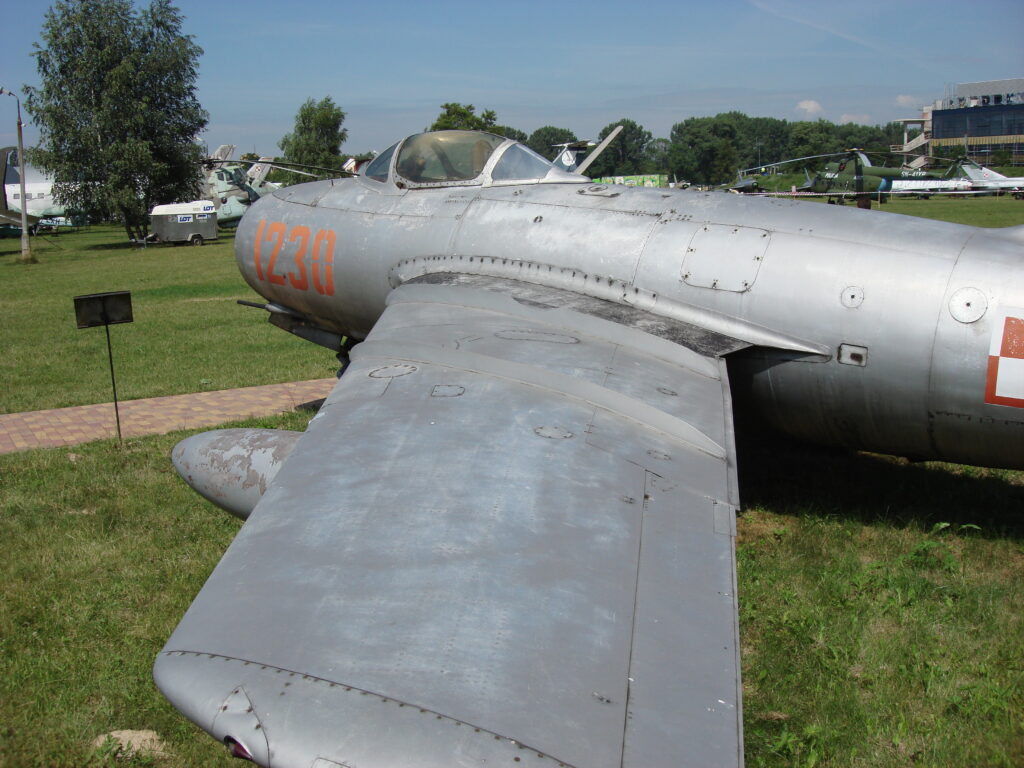
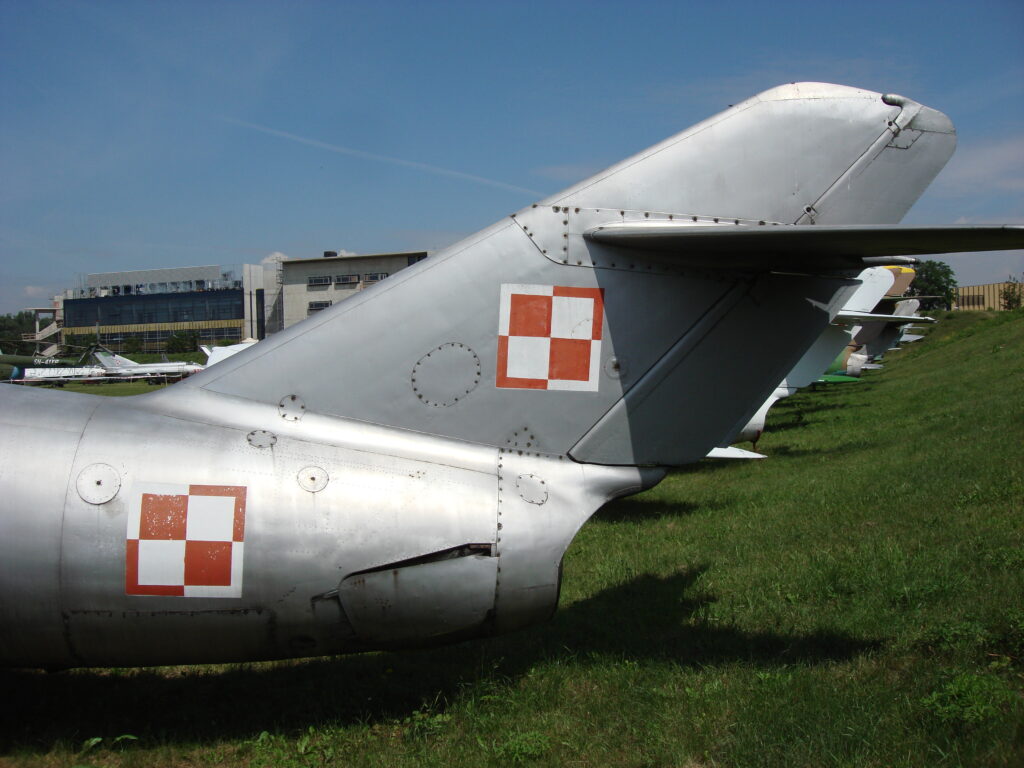
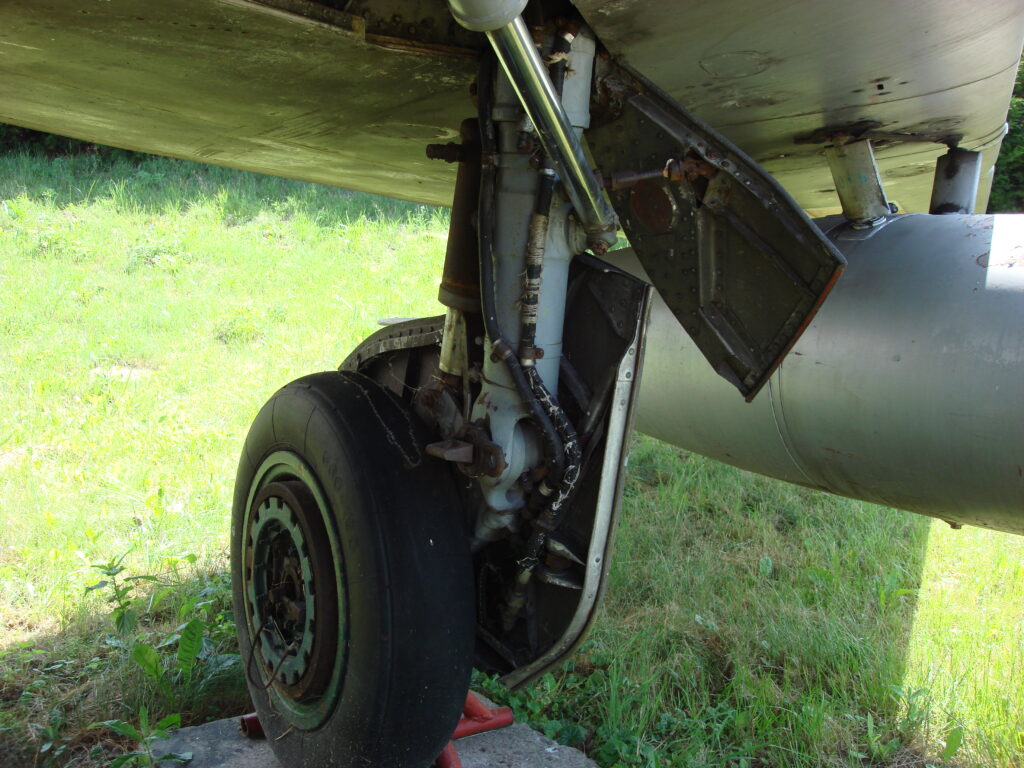
Lim-2 engine.
The drive is a single-shaft, single-flow turbojet engine designated WK-1 A (a development version of the RD-45 F engine) and designated Polish Lis-2, with a thrust of 1 x 26.46 kN (1 x 2,700 kG).
The engine is made of a single-stage, double-sided centrifugal compressor, behind which there are 9-jug combustion chambers, and behind them a 1-stage turbine. This turbine simultaneously drives the generator and the altitude compressor.
The fuel system consists of tanks placed in the fuselage and additional ones suspended under the wings. In the fuselage, the first rubber tank has a capacity of 1,245 liters. The rear tank consists of two halves with a capacity of 2 x 167 liters.
Two additional tanks are attached using universal BD-2-48MiG locks-holders, the same ones used to suspend bombs or cassettes with unguided rockets. The tanks have a capacity of 2 x 400 liters. They are made of duralumin or as two-part plastic. They can be dropped during the flight after the fuel is exhausted.
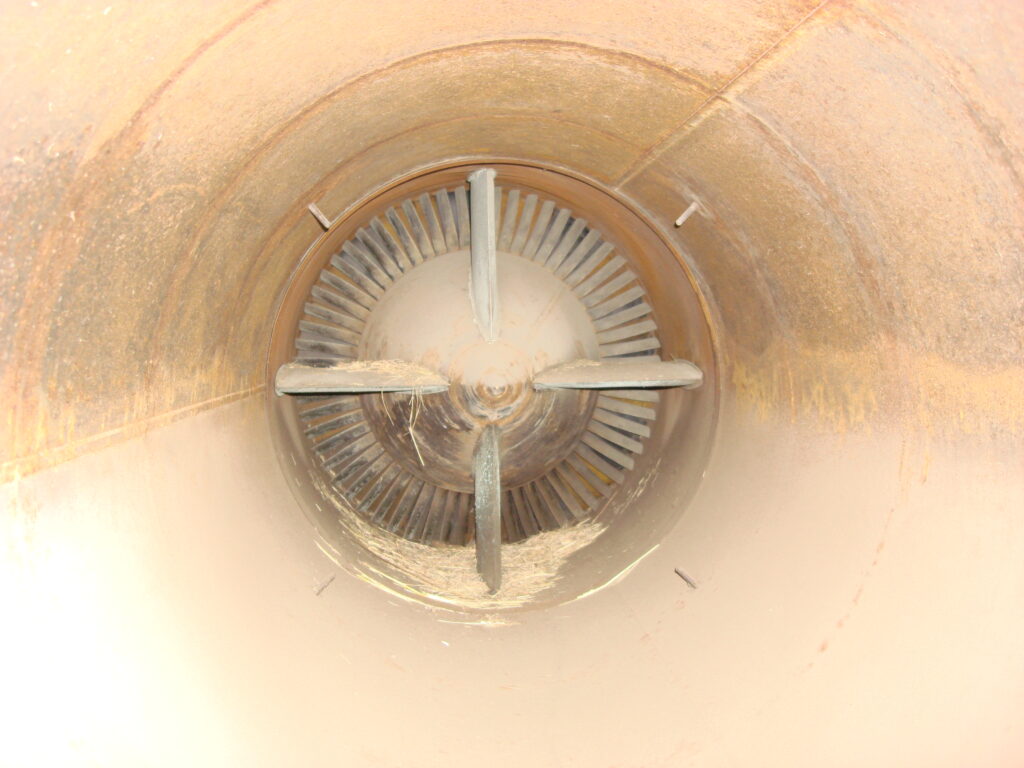
Lim-2 equipment.
R-800 radio transmission and reception station, ARK-5 automatic radio compass, KUS-1200 speedometer, WAR-75 variometer, EUP-48 turn indicator, AGI-1 artificial horizon, M-0.95 machometer, ASP-3 N or ASP-3 MN gyroscopic semi-automatic sight, later the newer AP-2 R enabling shooting of TRS-190 or ARS-212 unguided rocket missiles, S-13 camera gun taking 8 photos per second from 5 m of film. The aircraft also has: MRP-48 P radio beacon overflight indicator, RW-2 radio altimeter, SRU-0 reconnaissance identifier.
Lim-2 armament.
Armament; one 37 mm cannon, type N-37 (rate of fire 400 shots/minute) and two 23 mm cannons, type NR-23 (rate of fire 800-950 shots/minute). They were placed on a carriage lowered down, under the cabin floor. Other combinations of armament occurred. For example, older types of cannons were used.
Two additional fuel tanks under the wings. In subsequent years, the aircraft gained the ability to carry bombs and e.g. 4 pcs. TRS-190 or 2 pcs. ARS-212. The armament also included an EKSR-46 electro-flag signalling launcher with 4 colored cartridges, sometimes used in emergency to get out of a spin.
T-T PZL Lim-2 data:
Span 10.08 m. Length 10.10 m. Height 3.70 m. Load area 20.60 m2. Empty weight 3,681 kg. Weight with additional fuel tanks 3,720 kg. Total weight 5,044 kg. Maximum weight 6,045 kg. Payload weight 1,363 kg. Maximum speed 1,076 km/h. Maximum speed Ma-0.95. Climb speed 46 m/s. Cruising speed 860 km/h. Landing speed 190 km/h. Maximum range 2,000 km. Range with maximum payload 1,330 – 1,861 km. Flight time 2 hours 57 minutes. Maximum ceiling 15,000 m. Take-off run 500 – 504 m. Landing run 880 m.
Written by Karol Placha Hetman

